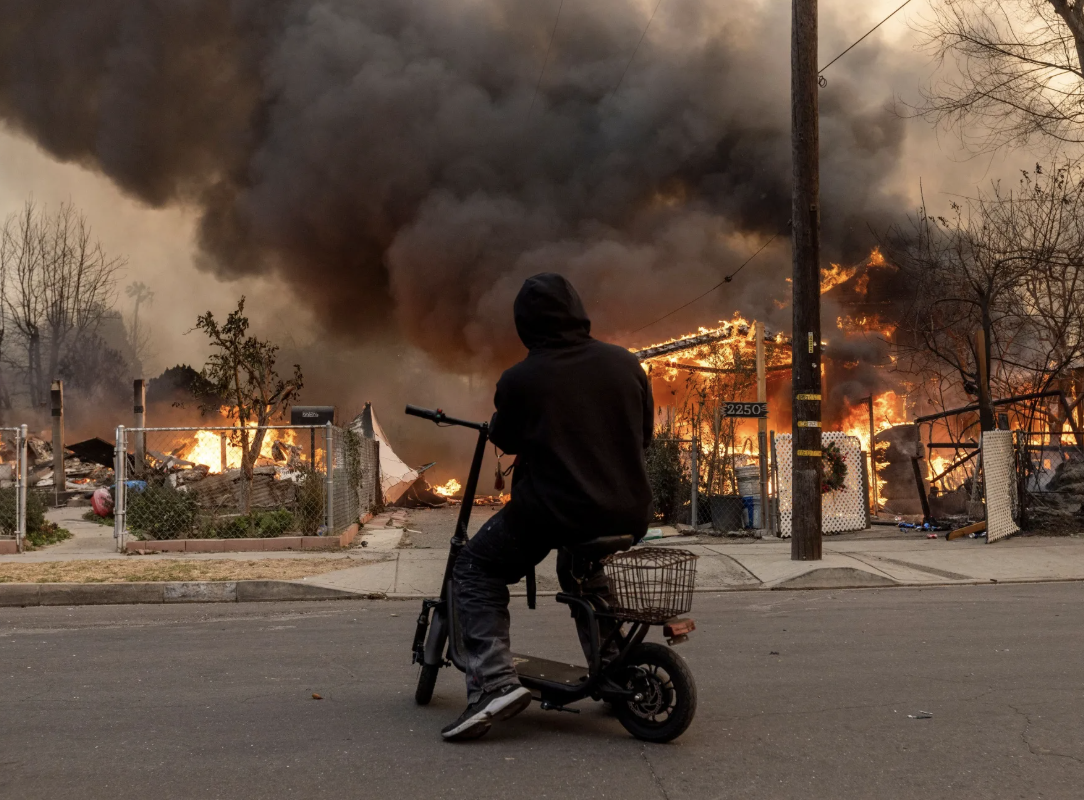- Speculators call home owners, agents in the wake of the fires
- Neighborhood northeast of LA was a haven for Black families
The devastating wildfires that recently swept through Los Angeles County have left communities like Altadena reeling. The flames that ravaged this middle-class enclave have attracted not only survivors but also real estate investors eager to capitalize on the damage. For residents, the looming threat of opportunistic speculators looking to buy fire-damaged properties at steep discounts has raised concerns over the future of the neighborhood, known for its rich history and diverse community, particularly among Black and Latino families.
Altadena: A Historic Haven for Black Homeownership
Altadena, nestled in the foothills of the San Gabriel Mountains northeast of Los Angeles, has long been a haven for middle-class working families, many of whom are Black. The community has maintained higher-than-average Black homeownership rates, thanks in part to its affordability compared to other areas in Los Angeles. But as the city faces escalating housing crises and gentrification pressures, the recent wildfires may push this historic neighborhood into a new chapter—one that residents fear could displace longtime residents.
Danielle Neal, a fourth-generation Altadena resident, has already witnessed speculators targeting her family’s property in the aftermath of the fires. “There’s not a lot of compassion,” Neal shared, describing the situation as “a version of looting.” Like many in her community, she worries that the neighborhood’s character could change drastically as investors move in, transforming it into something unrecognizable.
The Growing Concern Over Gentrification and Displacement
Altadena, like much of Los Angeles, has been dealing with gentrification for years. A January study from the University of Southern California revealed how the region’s housing problems—shaped by tightened loan standards and limited construction—have worsened over the decades. With the recent fires, residents face a dual crisis: an affordability gap and an influx of real estate investors targeting distressed properties.
The situation is not unique to Altadena. Other parts of Los Angeles that have experienced wildfires have seen similar patterns of investors seeking to profit from the misfortune of others. Local real estate agents, like Teresa Fuller of Compass, have been contacted by interested buyers from across the U.S., hoping to purchase damaged properties for pennies on the dollar.
Protecting Altadena’s Future: A Call for Community Action
In response to these predatory practices, California Governor Gavin Newsom issued an executive order on January 16, 2025, banning unsolicited, low-ball property offers in fire-affected areas for three months. This move aims to give homeowners the time and space they need to rebuild their lives without being pressured by investors offering quick sales.
However, not all residents agree on the approach to rebuilding. Gary Moody, a long-time Altadena resident and former head of the NAACP Pasadena chapter, advises survivors to “be patient” and avoid jumping into agreements too quickly. His warnings serve as a reminder to homeowners that FEMA has only just begun accepting applications for assistance and that taking the time to explore all options is essential for making informed decisions.
Rebuilding the Community: The Role of Local Architects and Organizations
As Altadena faces these challenges, community leaders are coming together to ensure the neighborhood remains a place where families can thrive. Scott Alan Rivers, an architect working to rebuild homes in wildfire-ravaged areas, highlights the importance of protecting communities like Altadena, where Black homeownership rates have remained higher than elsewhere in the country. “Black people, we have so few communities left—we cannot afford to lose another,” he said.
Members of the Southern California chapter of the National Organization of Minority Architects are joining forces with other groups to help Black homeowners navigate the rebuilding process and prevent exploitation from predatory investors.
Altadena’s Rich Legacy at Risk
The potential loss of Altadena’s character and diversity is a sobering reality for its residents. In 1960, the community was overwhelmingly White, but as the Civil Rights Movement led to greater access to credit for Black families, the neighborhood’s demographics shifted. By the time of the fires, roughly 60% of Altadena’s residents were from underrepresented groups.
As rebuilding efforts begin, the community’s focus is clear: preserve the essence of Altadena while addressing the challenges of a changing housing market. For those like Neal, whose family has deep roots in the area, there is a collective determination to keep “Altadena, Altadena.”
A Call to Action for Altadena Homeowners
For those impacted by the fires, it’s important to take time before making any major decisions regarding property sales or repairs. Real estate professionals, insurance experts, and legal advisors can help guide homeowners through the complex claims process and offer strategies for navigating this difficult time.
Altadena’s future is at a crossroads. While gentrification and speculative buying threaten the fabric of this beloved community, there is still hope for preserving its legacy. Residents, supported by local organizations and allies, are working to rebuild and protect what makes Altadena special—its history, diversity, and middle-class roots.
📞 Contact Abdo Pierre Faissal at 310-620-1038 | ✉️ [email protected] for trusted real estate advice.


